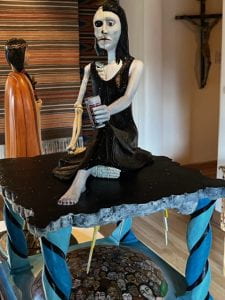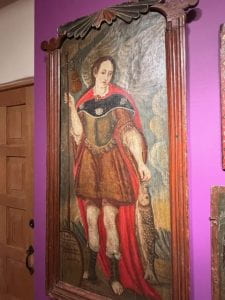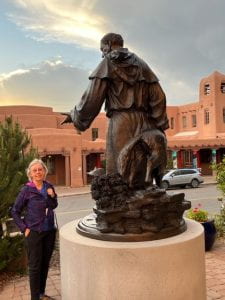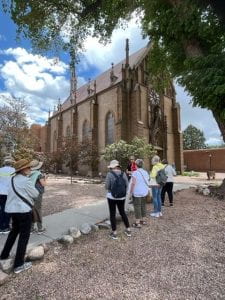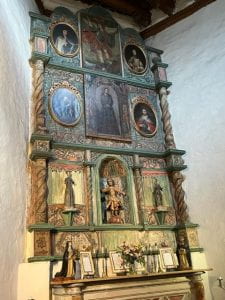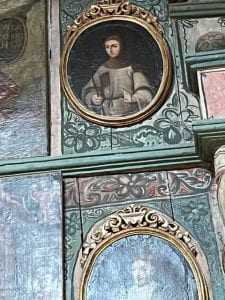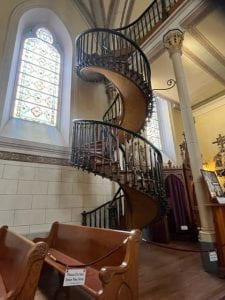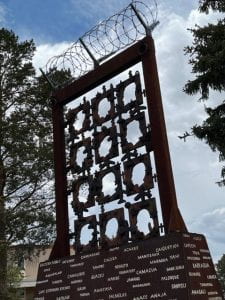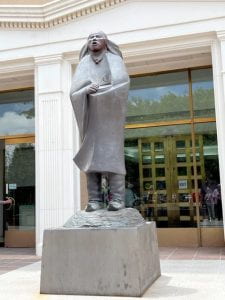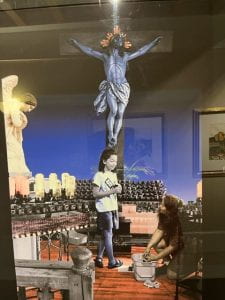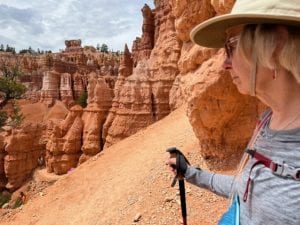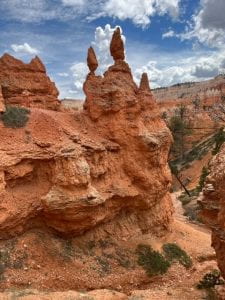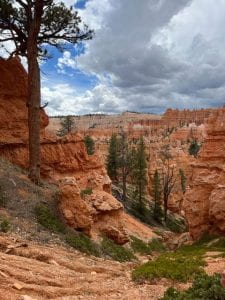 When I first noticed Bill Feiser across the aisle in church I thought he might be visiting from our partner congregation Temple Beth Emeth. He might even have been the rabbi with his bushy beard, deeply receding hairline, short stature, spectacles and head tilted slightly up toward the altar.
When I first noticed Bill Feiser across the aisle in church I thought he might be visiting from our partner congregation Temple Beth Emeth. He might even have been the rabbi with his bushy beard, deeply receding hairline, short stature, spectacles and head tilted slightly up toward the altar.
A few Sundays passed before I met him and his wife, Jill Crabtree, after church and found out he was a member of St. Clare’s (our) parish. His deliberate, hoarse speaking voice added to my fantasy of a rabbi, but I found out his experience was strongly Episcopalian, more years logged in churches called “St. __” than I would ever have.
One friend, Judie Erb, said, “Bill was a geode, unspectacular on the outside, multifaceted and beautiful on the inside. We shared a love of classical music, irreverent theological satire, science fiction and the inner life of plants. He delighted our group with his description of the writings of Terry Pratchett and his detailed knowledge of how to maintain an orchid with annual seasons of blooms for over 10 years.”
Joanie Carson said, he was “lost in the pages of diverse books and papers that he could magically pull out from what seemed an endless supply pile under or near his table.
When I first got to know Bill I was a disillusioned Evangelical. I thought I might be back-sliding toward a liberal Christianity I had never imagined adopting. Our friendship was often a liberal-activist-vs.- conflicted-moderate conversation that was never really a debate.
We went through late-life crises at about the same time. Kathy, my first wife, had died when I was 68 and already planning for retirement. Jill was showing signs of dementia, soon diagnosed as Alzheimer’s. She spent much of her day in an adult therapy program in 2016 and soon moved into nursing care at the Evangelical Home in Saline.
It was Bill’s idea that we meet regularly to check in with each other. I suggested the Barnes and Noble Cafe and later the Whole Foods Cafe, which had plenty of tables so we could meet with a little privacy. We met every Wednesday for lunch for the two years before I met Victoria and remarried. It was less crisis management than an opportunity to reflect on weekly stresses. It served us both well.
Bill and I had twin passions for the movies and dark beer. I really looked forward to periodic screenings at the Michigan Theater followed by a beer or two at Hop Cat or Knight’s, within walking distance of the theater. We easily agreed on the movies worth watching and even on interpretations much of the time.
I remember we saw a few biopics, including On the Basis of Sex, (the celebration of Ruth Bader Ginsberg), A Quiet Passion, (a sensitive portrayal of Emily Dickinson), and Ladybird (Academy Award nominated mother-daughter struggle), and Eighth Grade (a fond portrait of a painful adolescence). What an interesting compendium of women from the 19th and 20th centuries! There are not many men who would enjoy a diet of these movies as much as both of us did, but Bill and I were thorough-going feminists.
It was also Bill’s idea to revive the St. Clare’s writing group to share original pieces once a month or so. We had about half a dozen amateur writers, with completely different assets, attending most of the time. We had a couple of poets, a memoirist or two, an adapter of biblical stories, and some who reflected on recent events. Sometimes we observed a St. Clare’s tradition of writing about the lectionary reading for the week, but we were best when we wrote in our favored genres.
Bill’s writing usually drifted toward his own life, especially the challenges of partnering with a woman sinking deeper into Alzheimer’s. He wrote regularly about one of those painful years with touching vulnerability. I hope some of those writings have been preserved, because they could help others facing what we have come to call “the long good-bye.” We all believed writing was an excellent therapy for a man facing the gradual decline of his spouse.
When we decided to anthologize our work, seven of us contributed to a slim volume we called, To Find Out What Really is Mine, a title I lifted from a Nields song called “The River.” Bill selected a piece he wrote about helping to get a venue and an audience for a visiting Episcopal priest reporting the church’s work in El Salvador in 1986. “In our way Jill and I made a small contribution to the spreading of Liberation Theology in the Episcopal Church,” Bill wrote in conclusion. He called the memoir “A Small Effort.”
That is so Bill Feiser. He did not want to be known for accomplishments, even though he volunteered for many years for NAMI (National Alliance on Mental Illness) and periodically led St. Clare’s volunteers for Alpha House (homeless residence). He was unassuming to a fault. He wanted to be known, but not famous.
Joan remembered him this way: “I realize that he really was an everyday pilgrim, humbly slow waltzing his way through the streets of the heresy of activity. . . . He never seemed to rush a conversation. He waited patiently to share a kernel of truth within our seekers group.”
Bill was my witness and best man at our 2018 wedding. He donned a coat and tie in my honor. I can not remember another time he was actually dressed up, but there might have been one. He looks very proud in the photo, and I believe he was proud to be so honored. He had warned me about seeing my true love with “rose-colored glasses,” but once Victoria and I were engaged he was completely on board and always wanted me to give Victoria a hug when he wrote or called from Ann Arbor.
This past April (2023) was his last time visiting us in Missouri. We visited his favorite attraction, the Missouri Botanical Garden and a restaurant we had selected for barbecue– Pappy’s (see at top).
We breezed through the St. Louis Art Museum (“Monet/Mitchell: Painting the French Landscape”) and lingered at the Ulysses Grant Memorial one morning. Another day we took the famous Budweiser Brewery Tour.  Then we hit a brewery with honest dark beer: “Heavy Riff.” That was a celebration of past indulgences. We also heard the passionate Anthony Ray Hinton, the exonerated death row inmate. Not too hectic a week’s schedule, but probably a few gears up from the pace he had been used to. He seemed a little overwhelmed at times.
Then we hit a brewery with honest dark beer: “Heavy Riff.” That was a celebration of past indulgences. We also heard the passionate Anthony Ray Hinton, the exonerated death row inmate. Not too hectic a week’s schedule, but probably a few gears up from the pace he had been used to. He seemed a little overwhelmed at times.
After Bill texted that he had landed safely in Detroit, we did not hear much from him, but that was often Bill’s MO. He was hard to reach by every medium of communication, but a frontal assault with e-mailing, texting and voice-mailing usually produced results the same day.
Victoria and I were about to embark on two three-week journeys, first to the Southwest and then to Canada. On the trip home from Canada Judy Avery emailed us that he had been to Urgent Care. He sounded weak on the phone. I worried that he would not prioritize seeing his personal doctor, but he assured me he would. I’m sorry he didn’t and very sorry I did not stop in Ann Arbor on the way home.
Rest in glory, my friend.

Victoria and Bill at Central Park, Chesterfield MO

Bill at the Famous St. Louis Arch

Bill and Victoria at the Missouri Botanical Garden

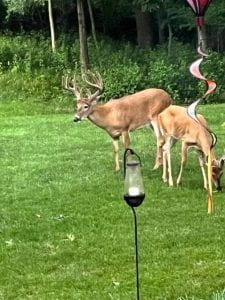
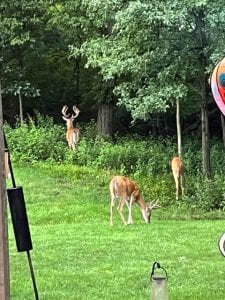
 When I first noticed Bill Feiser across the aisle in church I thought he might be visiting from our partner congregation Temple Beth Emeth. He might even have been the rabbi with his bushy beard, deeply receding hairline, short stature, spectacles and head tilted slightly up toward the altar.
When I first noticed Bill Feiser across the aisle in church I thought he might be visiting from our partner congregation Temple Beth Emeth. He might even have been the rabbi with his bushy beard, deeply receding hairline, short stature, spectacles and head tilted slightly up toward the altar.






.jpg)























